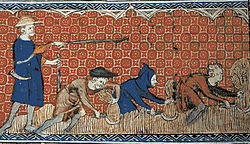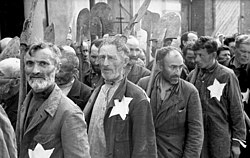Forced labor
Forced labor includes all forms of slavery and related practices including debt slavery, serfdom, human trafficking and labor camps. It is any work or service a person is forced to do against their will.[1] It usually includes a threat of some form of punishment.[1] The International Labour Organization had defined Forced labor as "all work or service which is exacted from any person under the menace of any penalty and for which the said person has not offered himself voluntarily."[2] This was in the Forced Labour Convention, 1930 (No. 29). Exceptions included work done while serving in a military organization, community service when the work serves the community, and anyone convicted and serving a prison sentence.[2] Convict labor must be supervised by public officials. The convention does not allow convicts to be under the supervision of private individuals, companies or organizations.[2]
There are over 29 million people living as slaves today.[3] There are an estimated 60,000 slaves living in the United States.[3] This includes prostitutes and sex workers, illegal immigrants and those held in debt bondage.[4]
Forced Labor Media
Clergy on forced labour, by Ivan Vladimirov (Soviet Russia, 1919)
Mine workers in Ancient Greece were often slaves
Ukrainian Ostarbeiters from Kyiv Oblast depart to Nazi Germany to serve as labor force, 1942
Depiction of socage on the royal demesne (miniature from the Queen Mary Psalter, c. 1310).British Library, London
Jewish forced labourers during the Holocaust in Mogilev, Belarus, July 1941.
Political prisoners eating lunch in a Gulag camp, 1955.
American prisoner "chain gang" labourers, 2006. Notice the shackles on the feet of the prisoners.
References
- ↑ 1.0 1.1 "FORCED LABOUR". Anti-Slavery International. Archived from the original on 4 April 2016. Retrieved 5 August 2015.
- ↑ 2.0 2.1 2.2 "International Labour Standards on Forced labour". International Labour Organization (ILO). Retrieved 5 August 2015.
- ↑ 3.0 3.1 Max Fisher (17 October 2013). "This map shows where the world's 30 million slaves live. There are 60,000 in the U.S." The Washington Post. Retrieved 5 August 2015.
- ↑ "What is Modern Slavery?". United States Department of State. Retrieved 5 August 2015.
| Wikimedia Commons has media related to Lua error in Module:Commons_link at line 62: attempt to index field 'wikibase' (a nil value).. |








